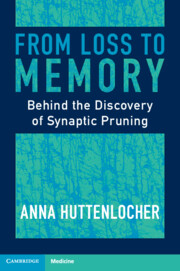Book contents
- From Loss to Memory
- From Loss to Memory
- Copyright page
- Dedication
- Contents
- Preface
- Acknowledgments
- 1 Counting Synapses
- 2 Discovering Synaptic Pruning
- 3 Else, Peter’s Mother
- 4 Richard, Peter’s Father, and Peter’s Uncle Fritz
- 5 Greiz: Kriegskinder (Children of War)
- 6 In Braubach, after the War
- 7 Arrival in America
- 8 Harvard Medical School
- 9 Understanding Sleep and Consciousness: Research at the National Institutes of Health
- 10 Entering the Cognitive Revolution: Neuroscience and Cognitive Psychology
- 11 Physician First, Scientist Second?
- 12 Comparative Brain Regions and Synapse Formation
- 13 Stimulating Progress on Developmental Brain Disorders
- 14 Neurodevelopmental Disorders and Schizophrenia: A Role for Synaptic Pruning?
- 15 Early Childhood Education
- 16 Peter and Janellen’s Collaboration
- 17 Microglial Cells and the Mechanisms of Synaptic Pruning
- 18 Looking Forward: Being a Physician and a Scientist
- 19 Parkinson’s Disease and Berlin
- 20 Auf Deutsch: Back to German
- 21 Memories and Reflections at the End: A Return Trip to Greiz
- Glossary
- Index
- References
10 - Entering the Cognitive Revolution: Neuroscience and Cognitive Psychology
Published online by Cambridge University Press: 10 October 2023
- From Loss to Memory
- From Loss to Memory
- Copyright page
- Dedication
- Contents
- Preface
- Acknowledgments
- 1 Counting Synapses
- 2 Discovering Synaptic Pruning
- 3 Else, Peter’s Mother
- 4 Richard, Peter’s Father, and Peter’s Uncle Fritz
- 5 Greiz: Kriegskinder (Children of War)
- 6 In Braubach, after the War
- 7 Arrival in America
- 8 Harvard Medical School
- 9 Understanding Sleep and Consciousness: Research at the National Institutes of Health
- 10 Entering the Cognitive Revolution: Neuroscience and Cognitive Psychology
- 11 Physician First, Scientist Second?
- 12 Comparative Brain Regions and Synapse Formation
- 13 Stimulating Progress on Developmental Brain Disorders
- 14 Neurodevelopmental Disorders and Schizophrenia: A Role for Synaptic Pruning?
- 15 Early Childhood Education
- 16 Peter and Janellen’s Collaboration
- 17 Microglial Cells and the Mechanisms of Synaptic Pruning
- 18 Looking Forward: Being a Physician and a Scientist
- 19 Parkinson’s Disease and Berlin
- 20 Auf Deutsch: Back to German
- 21 Memories and Reflections at the End: A Return Trip to Greiz
- Glossary
- Index
- References
Summary
The Cognitive Revolution was an intellectual movement in the 1950s and 1960s focused on using the scientific method to understand human cognition, otherwise known as the process of learning and memory. This revolution in the field of psychology was happening at the same time that neuroscientists like Hubel and Wiesel were exploring how neurons in the brain are organized to enable behaviors such as visual perception. It was in this environment that both Peter and Janellen developed further as scientists. The connections between their respective fields provided fodder for discussion and debate throughout their careers. Peter focused on cellular events and biological processes in developmental neuroscience, while Janellen probed the mechanisms of human verbal and mathematical learning and memory.
- Type
- Chapter
- Information
- From Loss to MemoryBehind the Discovery of Synaptic Pruning, pp. 64 - 68Publisher: Cambridge University PressPrint publication year: 2023



